Biology
Digestion & Nutrition
Nutrition
- A healthy person who stops eating can only survive for 40 days.
- We need food to be able to grow, repair, and to get energy for growth and repair, moving and keep warm.
- Our cells use nutrients to be able to do basic human features. We have a few types of nutrients such as proteins, carbohydrates, vitamins and minerals, and sometimes fibres.
- We get energy from carbohydrates and fats, and we use proteins for growth and repair.
- Proteins are especially important when we are growing as they make new cells. They are also important when injured as they are what help heal your wounds.
- Kwashiorkor is a disease that is caused by a lack of proteins. This causes someone to be really weak and skinny, and their hair would be thin, and they might have many wounds.
- Anything coming from animals has protein in it, such as meat, and dairy, as well as nuts and tofu.
- We can split carbohydrates into two different things. Sugary carbohydrates and starchy carbohydrates. Both carbohydrates give energy, however, sugary carbohydrates give short-term energy, while starchy gives out long-term energy. In the end, they both turn into glucose.
- You need carbohydrates for energy so the body can utilize the proteins and so we can move, keep warm and be able to actually use the protein to make new cells.
- Some examples of starchy carbohydrates are bread, rice, potatoes, etc., and some examples of sugary carbohydrates are fruits, especially apples, and cotton candies.
- Fats are very similar to carbohydrates; however, they are less healthy and having too many fats can cause obesity. Fats give long-term energy. Some examples of fats are oil and butter.
- We measure energy in kilojoules.
- \
| Activity | kJ/hour |
|---|---|
| Sitting | 63 |
| Standing | 84 |
| Walking | 750 |
| Swimming | 1800 |
| Walking upstairs | 4184 |
| Sprinting | 5183 |
- We use energy all the time, even while asleep, just to breath or have our brains work.
- Vitamins are also vital, as they have multiple different functions depending on what vitamin it is but are also important to using other nutrients. You can find vitamins in many things, but especially in fruits and vegetables, like apples and carrots. Minerals are also very similar, however you find minerals in very specific things, such as milk and spinach.
- For example, Vitamin C is a vitamin, and it is helpful for sticking cells together and keeping gums strong. If you have a deficiency of vitamin C, you will get scurvy, which makes your teeth rot and fall out, and can cause your gums to bleed out.
- Two examples of minerals are calcium and iron. Calcium is important for making up bones and your teeth, and iron is important for making red blood cells. If you don’t have enough iron, you will have anemia, which will cause fatigue, dizziness and other symptoms.
- We use fibers to be able to push out food as we do not have enzymes to break down the fibers. If we don’t have enough fibers, we will be constipated. Fibers are found in anything plants, as the plant cell walls contain fibers, and we cannot break down the enzymes. For example, you can find fibers in vegetables such as cucumbers, or fruits such as tomatoes, and many others. It excretes faeces.
- Water has a similar function, as water also helps push food out your body, however it also helps make blood and most of our body is made out of water. You can find water in all foods, especially watermelons and oranges and other citrus fruits. It excretes faeces.
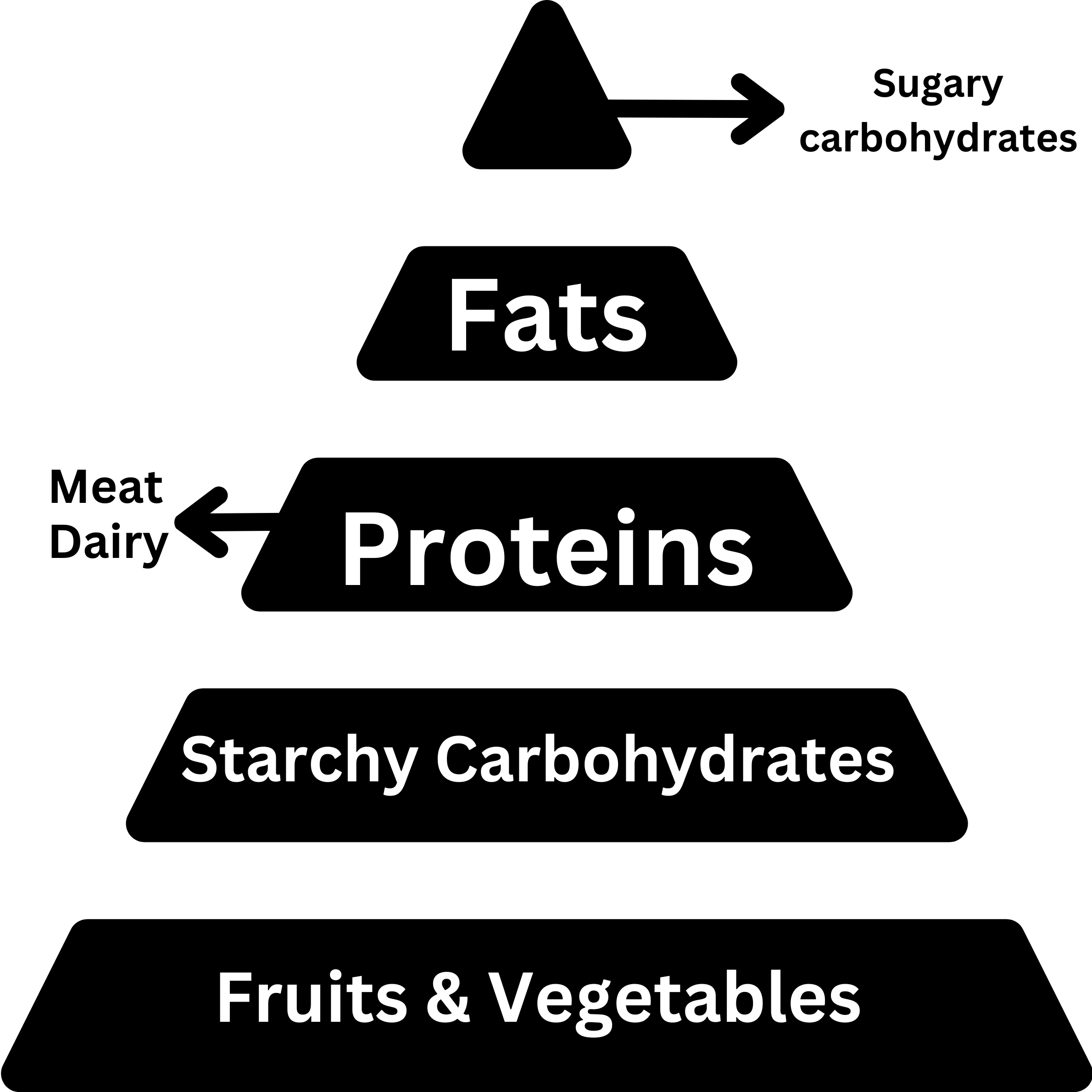
Digestion
When nutrients that are in your food go into your blood, you are absorbing the nutrients. However, when you need to break down the nutrients so they’re small enough to absorb, that is called digestion. As soon as they are digested, they are absorbed.
Digestion is the breaking down of large, insoluble food molecules into small, soluble ones by the body for absorption.
There are some nutrients you can absorb without digesting them, as they are small enough, such as vitamins, minerals and sugary carbohydrates.
We have enzymes to break down the nutrients.
After the nutrients are absorbed, they go into your blood and travel to your cells due to diffusion.
Starch is too big to be absorbed so it has to be digested, and it is digested into sugars (glucose)
The digestive journey begins in the mouth and goes down the oesophagus (gullet) where muscles push the food down. Then, it goes through the stomach and into the small intestine where the liver and pancreas release enzymes which helps us digest our food and is absorbed, and then goes to the large intestine which is where you absorb water into your blood, and then it goes out the anus.
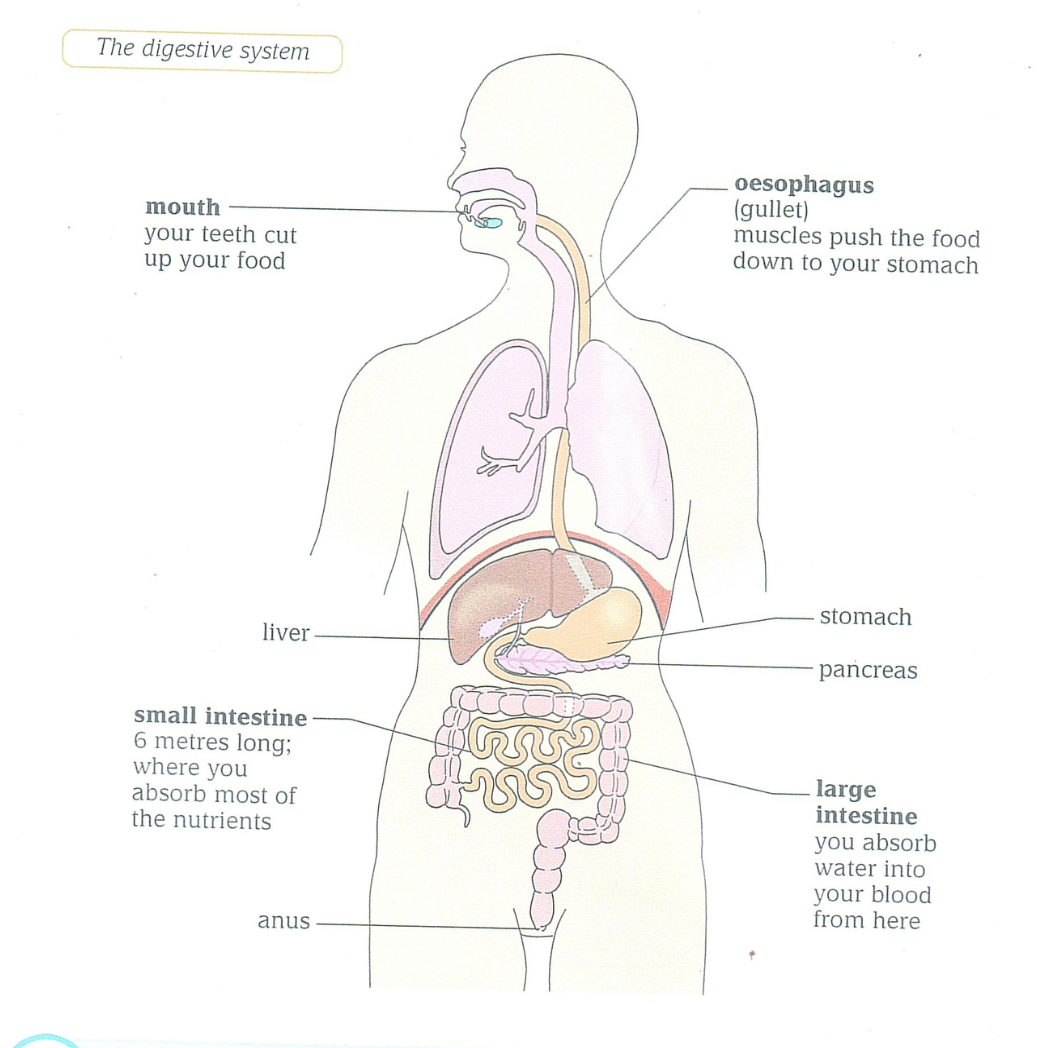
The liver converts glucose into glycogen for storage, which is used when you are not getting nutrients.
Proteins get digested into amino acids, which are ordered differently depending on what cell they are going to or going to be created as.
Egestion is when undigested food leaves your body as faeces.
Enzymes are specific as each enzyme breaks down a different kind of molecule.
Fats break down using insulin into fatty acids and glycerol.
Circulation
Circulation is the transport of blood (which carries glucose and oxygen) around the body.
The heart is a muscle that pumps blood all around your body. It is divided into the right and left side by a septum. Each side is also divided into two parts: the atrium (at the top) and the ventricle (at the bottom).
The arteries take blood out the heart and around the body and the veins bring blood into the heart.
Veins have valves which stop the blood going the wrong direction and causing complications. Arteries do not have them as the blood flow is strong enough to make the blood constantly flow correctly. Valves open when blood is flowing in the right direction, and the valves shut if the blood tries to flow in the opposite direction.
Capillaries are tiny tubes which are extremely thin, making them really productive for gas exchange as they can go in and out really easily.
The process beings when blood filled with carbon dioxide, due to it being around the body and collecting the waste products, and it enters the right atrium. From the right atrium it goes down to the right ventricle and up to an artery leading to the lungs. This artery splits into a capillary which puts the carbon dioxide in the lungs and the oxygen in the capillary leading to a vein going back to the heart, and into the left atrium, which is now lighter due to it being containing oxygen. The blood then goes to the left ventricle and from an artery, it goes to the whole body and the process is repeated.
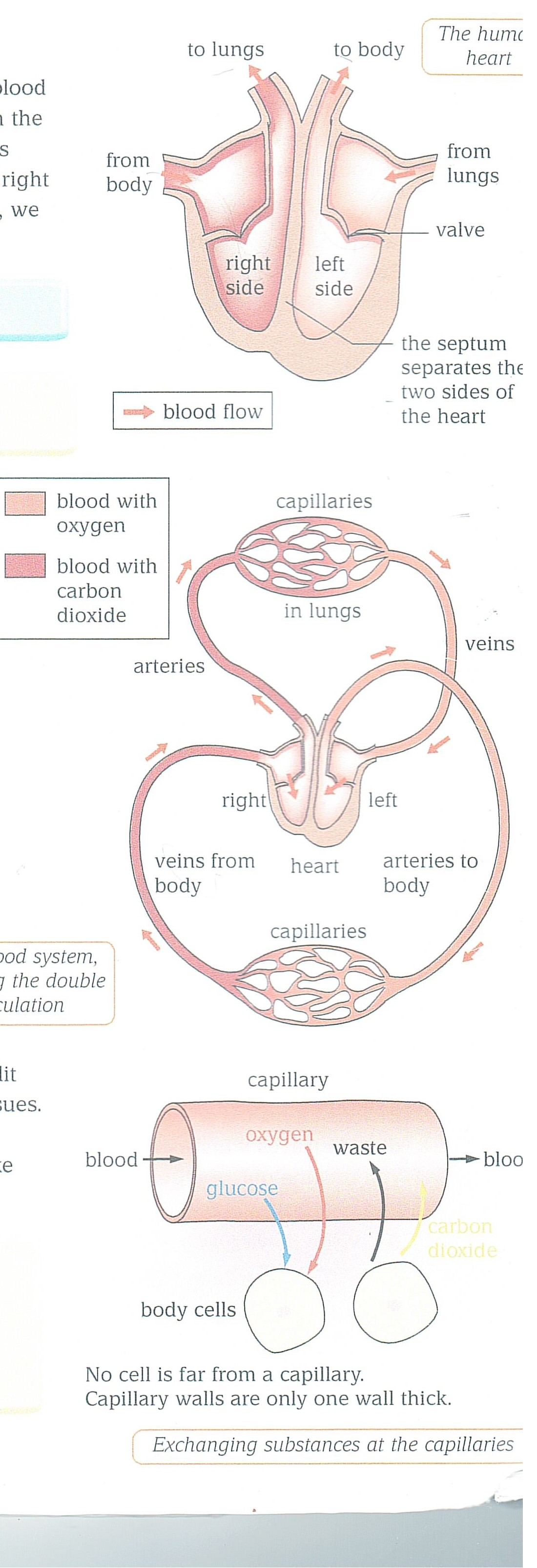
The right has deoxygenated blood, while the left has oxygenated blood. This is because the right has to pump blood to the lungs to get the oxygen, while the left needs to pump the oxygen to the whole body. The left side is bigger due to this.
Respiration
Aerobic respiration is a chemical reaction that happens in your cells. The two reactants are glucose and oxygen, and the products are carbon dioxide, water and energy, however carbon dioxide and water are waste products and are breathed out.
Glucose + Oxygen → Energy + Carbon Dioxide + Water
Around our cells, there is a fluid called tissue fluid that makes the journey from the blood to the cells easier, as they are just travelling through liquids.
The process of oxygen reaching your cells is the following:
Oxygen in air → Oxygen in lungs → Oxygen in blood → Oxygen in tissue fluid → Oxygen in cells.
Diffusion is the movement of substances from high to low concentrations. Oxygen diffuses from the lungs, which has a high concentration, to your blood, which has a low concentration.
When you are at high altitudes, the air molecules are more spread out and are thinner, and so you are taking in less oxygen. Due to this lack of oxygen, when you are at high altitudes, you will get sick and develop altitude sickness, which makes you nauseous, fatigued and you will get a bad headache.
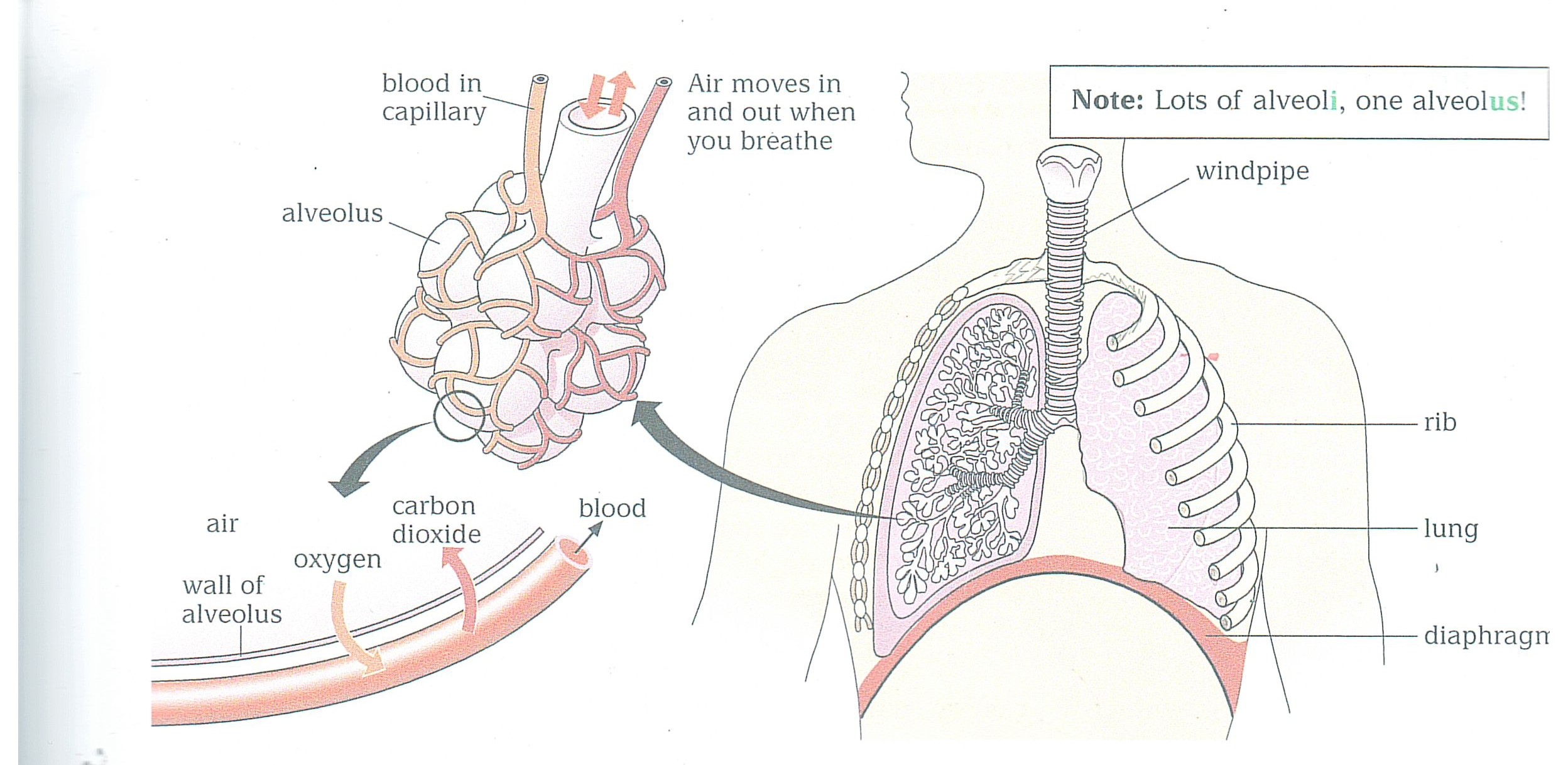
You breathe air in and out of your lungs. In your lungs, oxygen from the air diffuses into your blood, and at the same time, carbon dioxide and water, which are waste products of respiration, are breathed out into the air. This is called a gas exchange.
You breathe out more carbon dioxide than you breathed in, and you breath in more oxygen than you breath out.
The lungs contain many air sacs called alveoli. Alveoli are spongy and have a large surface area. The walls of the alveoli are very thin (one cell thick) and are surrounded by many capillaries. Capillaries also have a wall that is one cell thick, which makes gas exchange very easy as gasses can pass by really easily.
You have a trachea, which is the pipe connecting to the nose and the mouth and where oxygen goes. After that, it connects to bronchi which spread out into bronchioles and those bronchioles are connected to alveoli.
Nose/mouth → Trachea → Bronchi → Bronchioles → Alveoli.
Due to the alveoli being arranged in many small bubbles, there is a larger surface area. There is more area that can be in contact with capillaries which helps O2 diffuse faster.
Coughing damages your alveoli, and smokers tend to cough as tobacco irritates their breathing system. They more they are damaged, the smaller the surface area. If there is a smaller surface area, not as many capillaries can go around the alveoli and therefore gas exchange is more difficult.
The following table represents what gasses we breath in and what gasses we breath out.
| Gas | Air breathed in (%) | Air breathed out (%) |
|---|---|---|
| Oxygen | 21 | 17 |
| Carbon Dioxide | 0.03 | 4 |
| Nitrogen | 79 | 79 |
| Water vapor | Varies | Saturated |
- You can see your breath on a mirror when you breath it out, as the water waste product from respiration is going from a place where it’s really hot, to a place where it’s colder, like a surface of a mirror.
- You can test whether or not respiration has happened, and whether or not you’re breathing out carbon dioxide using an experiment.
- There are two liquids that change colour when in contact with carbon dioxide; limewater (which goes from clear to milky white) and hydrogen carbonate indicator (which goes from orange to yellow). In addition, phenol red is a carbon dioxide indicator, going from red/orange to yellow.
- You can check whether other living things respire by experimenting it. Put woodlice in a tube with a carbon dioxide indicator and wait a few hours and check if the colour has changed.
- To confirm that the woodlice has actually caused the colour change, get another tube without woodlice. Everything in the tubes should be the exact same except the fact that the woodlice are there. This is called a control experiment.
Reproduction
The female reproduction system and the male reproduction system are very different.
The female reproduction system has the following parts:
Ovum, Ovary, Oviduct, Uterus, Cervix and Vagina.
The male reproduction system has the following parts:
Testes, Scrotum, Sperm Duct, Sperm, and Penis.
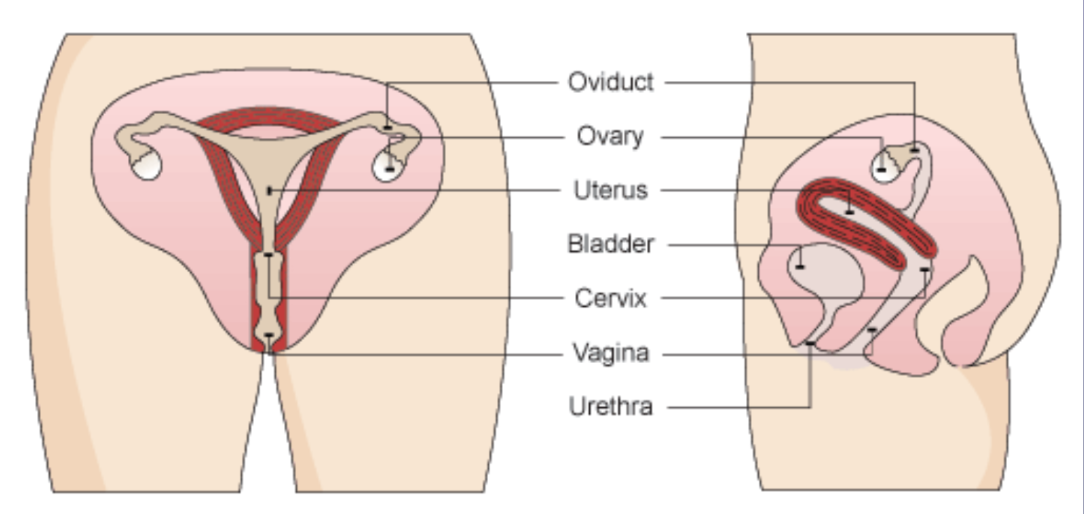
The ovary holds the ovum, which is the egg, which is one of the two parts required for reproduction. The oviduct is where the sperm and the ovum meet. The uterus is where the foetus is made and held. The bladder is where you hold your pee and your urethra is where you pee out from. The cervix is a part separating the uterus and the vagina. The vagina meets the penis and that is where the sperm is inserted.
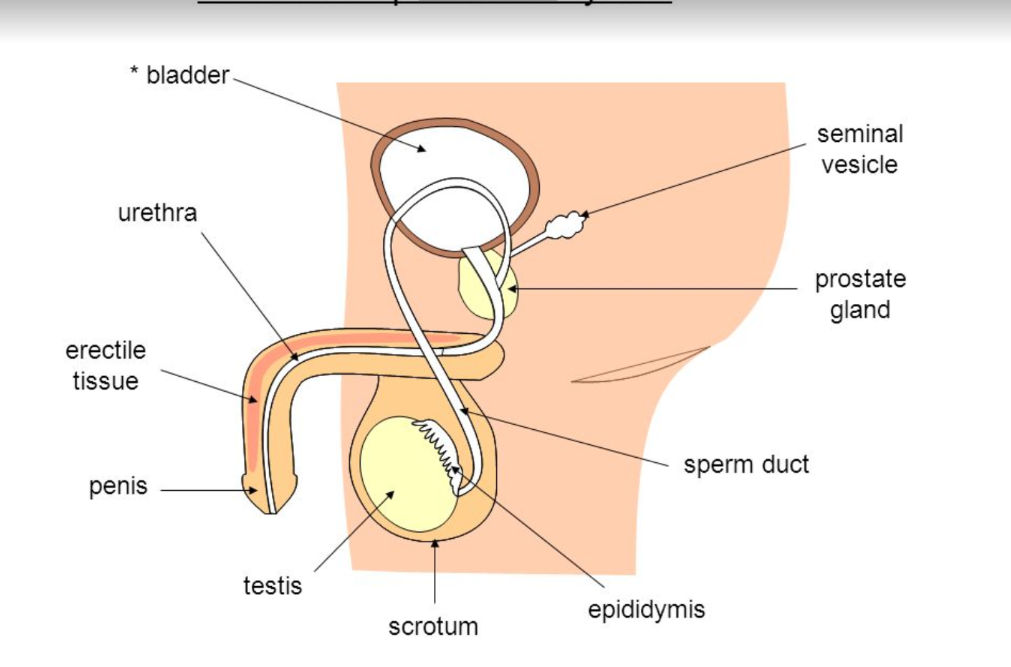
The penis is the big stick thing, which is connected to the urethra, which is connected to the sperm duct at the gland, which is connected to the testes. The urethra is where both sperm and pee come out from. The bladder is where pee is held. The sperm duct is a pipe connected to the testes and the urethra. It gets the sperm from the testes and gives the sperm to the urethra at the gland. The testes hold and make sperm and the scrotum holds the testes ‘outside’ the body, as the sperm cannot be heated up or else it could be bad for the sperms functions.
The uterus is sometimes called the womb. If an egg fertilizes with sperm, it implants into the wall and develops into a foetus.
The cervix is the opening, or the ‘neck’, of the uterus and it is on top of the vagina.
The vagina connects the cervix to the outside of the body and the sperm is deposited here during sex.
The female sex cell is called ovum, or egg. The male sex cell is called sperm. The sperm is designed to swim from the vagina to the oviduct.
After puberty starts for a woman, every month (or 28 days) an egg or ovum is released from the ovary.
The oviduct carries the ovum from the ovary to the uterus and this is where the sperm meets the ovum, and the ovum is fertilized here.
The scrotum is a sack of skin that holds the testes, and the testes make sperm continuously after puberty.
The sperm goes from the testes to the sperm duct, and the sperm duct meets the urethra in the glands, and they are connected there, and then the sperm is ejaculated out the body.
Sperm in testes → Sperm in sperm duct → Sperm in urethra → Sperm ejaculated.
The egg and the sperm contain 50% of the DNA needed to make a human, and together they make 100% of a human.
The egg is large and has a food storage to be able to feed the foetus when required, mostly proteins and fats, and the egg cannot move much. Not many are made; only 1 or 2 per month. If an egg is not fertilized in a month, it leaves the body to create new ones.
The sperm is small and has no food storage. It can move a lot, as it has a tail for swimming to be able to reach the egg. Millions of sperm are made each day.
Fertilization happens in the oviduct which is where the sperm meets the egg. The fertilized egg passes into the uterus and implants into the wall. The cell begins to divide into 2, then 4, then 8, and so on and so forth. This division of cells makes the foetus.
The placenta allows the exchange of food, water, oxygen from the mother to the baby and the exchange of waste products from the baby to the mother through the umbilical cord. The placenta has a large surface area.
The baby is surrounded by amniotic fluid which provides protection and cushioning for the baby.